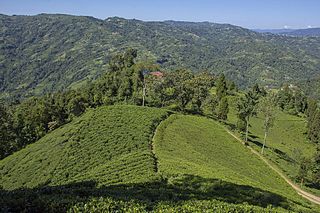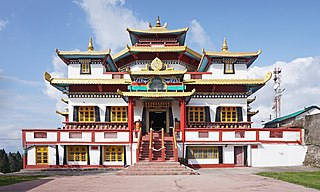Related Research Articles

Darjeeling is a town and municipality in the northernmost region of the Indian state of West Bengal. Located in the Eastern Himalayas, it has an average elevation of 2,045 metres (6,709 ft). To the west of Darjeeling lies the easternmost province of Nepal, to the east the Kingdom of Bhutan, to the north the Indian state of Sikkim, and farther north the Tibet Autonomous Region region of China. Bangladesh lies to the south and southeast, and most of the state of West Bengal lies to the south and southwest, connected to the Darjeeling region by a narrow tract. Kangchenjunga, the world's third-highest mountain, rises to the north and is prominently visible on clear days.

Kalimpong is a town and the headquarters of an eponymous district in the Indian state of West Bengal. It is located at an average elevation of 1,250 metres (4,101 ft). The town is the headquarters of the Kalimpong district. The region comes under Gorkhaland Territorial Administration which is an autonomous governing body within the state of West Bengal. The Indian Army's 27 Mountain Division is located on the outskirts of the city.

Gorkha National Liberation Front (GNLF) is a political party in the Darjeeling District of West Bengal, India. It was formed in 1980 by Subhash Ghisingh with the objective of demanding a Gorkhaland state within India.

Namchi District is a district of the Indian state of Sikkim. Its headquarters is at Namchi.

Darjeeling District is the northernmost district of the state of West Bengal in eastern India in the foothills of the Himalayas. The district is famous for its hill station and Darjeeling tea. Darjeeling is the district headquarters.

Darjeeling tea is a tea made from Camellia sinensis var. sinensis that is grown and processed in Darjeeling district or Kalimpong district in West Bengal, India. Since 2004, the term Darjeeling tea has been a registered geographical indication referring to products produced on certain estates within Darjeeling and Kalimpong. The tea leaves are processed as black tea, though some estates have expanded their product offerings to include leaves suitable for making green, white, and oolong teas.

Ilam district is one of 14 districts of Koshi Province of eastern Nepal. It is a Hill district and covers 1,703 km2 (658 sq mi). The 2011 census counted 290,254 population. The municipality of Ilam is the district headquarters and is about 600 km (370 mi) from Kathmandu.

Kurseong is a town and a municipality in Darjeeling district in the Indian state of West Bengal. It is the headquarters of the Kurseong subdivision.

Mirik is a small town and a Notified Area of Darjeeling district in the state of West Bengal, India. It is the headquarters of the Mirik subdivision. The name Mirik comes from the Lepcha words Mir-Yok meaning "place burnt by fire".

The History of Darjeeling covers the history of Darjeeling town and its adjoining hill areas belonging to Sikkim, but eventually part of British India so now in the Indian state of West Bengal, which is intertwined with the history of Nepal, Sikkim, Bhutan, Bengal and Great Britain. Part of the state of Sikkim, Darjeeling became part of an important buffer state between Nepal and Bhutan. The British, using the area as a sanitorium, found that the climate provided excellent tea-cultivating conditions and soon began to grow tea on the hills of Darjeeling. Darjeeling tea remains a world-renowned export from Darjeeling.
Pokhriabong is a village in the Jorebunglow Sukhiapokri CD block in the Darjeeling Sadar subdivision of the Darjeeling district in West Bengal, India.

Sukhia Pokhri is a census town in the Jorebunglow Sukhiapokhri CD block in the Darjeeling Sadar subdivision of the Darjeeling district in the indian state of West Bengal. It is located 11 km from Ghum on the way to Mirik.

The culture of Darjeeling, India, is diverse and has a regional distinctness.
Gorubathan is a village in the Gorubathan CD block in the Kalimpong Sadar subdivision of the Kalimpong district in the Indian state of West Bengal.

Soureni is a village in the Mirik CD block in the Mirik subdivision of the Darjeeling district, in West Bengal, India.

Indian Gorkhas, also known as Nepali Indians, are Nepali language-speaking citizens in the Indian Republic. The modern term "Indian Gorkha" is used to differentiate the ethnic Gorkhas from Nepalis.

Kalimpong district is a district in the state of West Bengal, India. Originally known as Dalingkot tehsil, the region was alternatively under the control of Sikkim and Bhutan. In 1865, it was annexed from Bhutan by British India under the Treaty of Sinchula, and administered as a subdivision of the Darjeeling district from 1916 to 2017. In 2017, it was carved out as a separate district to become the 21st district of West Bengal.
Chongtong Tea Garden is a census town in the Darjeeling Pulbazar CD block in the Darjeeling Sadar subdivision of the Darjeeling district in the state of West Bengal, India.
Soom Tea Garden is a village in the Darjeeling Pulbazar CD block in the Darjeeling Sadar subdivision of the Darjeeling district in the state of West Bengal, India.
Dhajea Tea Garden is a village in the Jorebunglow Sukhiapokhri CD block in the Darjeeling Sadar subdivision of the Darjeeling district in the state of West Bengal, India.
References
- 1 2 Mondal & Roychowdhury 2018, p. 367.
- ↑ Middleton & Shneiderman 2018, pp. 158–159: "Early Nepali literary stalwarts like Parasmani Pradhan used both the terms Nepali and Gorkha interchangeably... Thus early associations of the Nepalis in India... used the word "Gorkha" to denote Nepalis of Indian origin".
- 1 2 Besky 2014, p. 84.
- 1 2 3 4 Khawas, Vimal (2003). "Urban Management in Darjeeling Himalaya: A Case Study of Darjeeling Municipality". The Mountain Forum. Archived from the original on 20 October 2004. Retrieved 1 May 2006.
- ↑ "Urban agglomerations/cities having population 1 lakh and above" (PDF). Provisional population totals, census of India 2011. The registrar general & census commissioner, India. Retrieved 12 February 2012.
- 1 2 Mandal, Dilip (13 May 2022). "Decade without data – Why India is delaying Census when US, UK, China went ahead during Covid". The Print. Retrieved 30 July 2022.
In all likelihood, India will not have its decadal census any time soon. The logjam is such that it may lead to a situation where a whole decade goes by without any official data on India and Indians. 2021 was a Census year and the Narendra Modi government decided not to conduct it due to the Covid pandemic. Now, Home Minister Amit Shah has said that the next Census will be an e-survey and carried out by 2024—it will be India's first 'digital Census'.
- 1 2 3 4 5 6 7 Mondal & Roychowdhury 2018, p. 368.
- ↑ Directorate of Census Operations, West Bengal (2003). "Table-4 Population, Decadal Growth Rate, Density and General Sex Ratio by Residence and Sex, West Bengal/ District/ Sub District, 1991 and 2001". Archived from the original on 27 August 2005. Retrieved 30 April 2006.
- ↑ "Table C-01 Population by Religion: West Bengal". censusindia.gov.in. Registrar General and Census Commissioner of India. 2011.
- 1 2 3 4 Lama & Rai 2016, p. 90.
- ↑ "Table C-16 Population by Mother Tongue: West Bengal". www.censusindia.gov.in. Registrar General and Census Commissioner of India.
- ↑ Middleton & Shneiderman 2018, Note on Language.
- 1 2 Brown, Scrase & Ganguly-Scrase 2017, p. 535.
- 1 2 Brown, Scrase & Ganguly-Scrase 2017, pp. 535–536.
- ↑ Brown, Scrase & Ganguly-Scrase 2017, pp. 535–538.